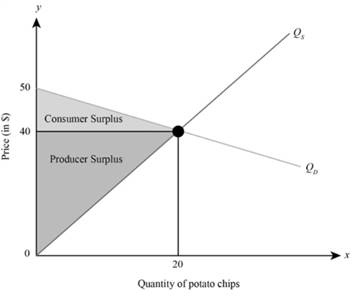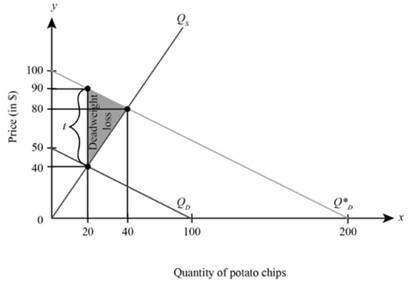
a)
To calculate: The
a)
Explanation of Solution
Given the following
The
To calculate equilibrium, we need to substitute
Hence, the equilibrium quantity and price with respect to given demand and supply function is Q = 20 and P = $40.
In order to calculate conumer surplus, producer surplus and social welfare we need to plot the above demand and supply function.

In the graph, the x axis depicts the quantity of potato chips and the y axis depicts the price per potato chips (in $),
Consumer surplus in the graph is represented by triangle A, so to compute consumer surplus, we need to calculate the area of the triangle. Thus, consumer surplus (CS) is
Producer surplus in the graph is represented by triangle B, so to compute producer surplus, we need to calculate the area of the triangle. Thus, producer surplus (PS) is
Social welfare (SW) is the sum of consumer surplus and producer surplus. Thus,
Introduction:
The equilibrium price is the defined as the price level at which both consumer and producer satisfies. It is the price where both want to exchange commodities and services.
b)
To compute: The equilibrium quantity, price, and
b)
Explanation of Solution
Given information:
Perceived demand function,
Supply function,
The equilibrium price is calculated by equating the supply and demand function. Thus, in equilibrium
In order to calculate equilibrium quantity, we need to substitute P = $80 into either the demand or supply function. Thus, equilibrium quantity is
Hence, the equilibrium quantity and price with respect to given demand and supply function is
In order to calculate deadweight loss we need to plot the above demand function and supply function. This has been done below:

In the graph, the x axis measures the quantity of potato chips and the y axis measures the price per potato chips (in $),
When it assumed that consumer behavious is influenced by his or her limited cognitive ability, then his percieved demand curve is
The deadweight loss indicating loss in social welfare due to extra purchase of potato chips than required is represented by triangle C and D. to compute the deadweight loss we need to calculate the area of triangle C and D. Thus
Thus, deadweight loss is
Introduction: A deadweight loss is an expense to economy that is caused by market failure, when supply and demand are out of equilibrium. Primarily used in economics, deadweight loss can be extended to any deficit caused by inadequate resource allocation.
c)
To compute: The per unit tax that the government could impose to correct the deadweight loss problem.
c)
Explanation of Solution
In order to correct the deadweight loss of 500 due to extra purchase of potato chips, government could impose a specific tax,
As a result, the consumer will reduce its purchase of potato chips from 40 units to 20 units on account of increased price of potato chips to $90.
Introduction: A deadweight loss is an expense to economy that is caused by market failure, when supply and demand are out of equilibrium. Primarily used in economics, the loss of deadweight can be extended to any deficit caused by inadequate resource allocation.
d)
To compute: The deadweight loss the governement has introduced with the tax if instead the government made a mistake and the second demand is actually the true demand stemming from rational decisions.
d)
Explanation of Solution
Dead weight loss happens when there is no equilibrium between supply and demand which leads to market failure. Market inefficiency happens when products are either overvalued or undervalued inside the industry. Although the disparity will favor some people in society, a change from equilibrium would negatively affect others.
If it is assumed that
Introduction: A deadweight loss is an expense to economy that is caused by market failure, when supply and demand are out of equilibrium. Primarily used in economics, the loss of deadweight can be extended to any deficit caused by inadequate resource allocation.
Want to see more full solutions like this?
Chapter 17 Solutions
EBK INTERMEDIATE MICROECONOMICS AND ITS
- How Command Economics Relate to Principle Of Economics?arrow_forwardhow commond economies relate to principle Of Economics ?arrow_forwardCritically analyse the five (5) characteristics of Ubuntu and provide examples of how they apply to the National Health Insurance (NHI) in South Africa.arrow_forward
- Critically analyse the five (5) characteristics of Ubuntu and provide examples of how they apply to the National Health Insurance (NHI) in South Africa.arrow_forwardOutline the nine (9) consumer rights as specified in the Consumer Rights Act in South Africa.arrow_forwardIn what ways could you show the attractiveness of Philippines in the form of videos/campaigns to foreign investors? Cite 10 examples.arrow_forward
- Explain the following terms and provide an example for each term: • Corruption • Fraud • Briberyarrow_forwardIn what ways could you show the attractiveness of a country in the form of videos/campaigns?arrow_forwardWith the VBS scenario in mind, debate with your own words the view that stakeholders are the primary reason why business ethics must be implemented.arrow_forward
- The unethical decisions taken by the VBS management affected the lives of many of their clients who trusted their business and services You are appointed as an ethics officer at Tyme Bank. Advise the management regarding the role of legislation in South Africa in providing the legal framework for business operations.arrow_forwardTyme Bank is a developing bank in South Africa and could potentially encounter challenges similar to those faced by VBS in the future. Explain five (5) benefits of applying business ethics at Tyme Bank to prevent similar ethical scandals.arrow_forward1.3. Explain the five (5) ethical challenges that can be associated with the implementation of the National Health Insurance (NHI) in South Africa.arrow_forward


 Managerial Economics: A Problem Solving ApproachEconomicsISBN:9781337106665Author:Luke M. Froeb, Brian T. McCann, Michael R. Ward, Mike ShorPublisher:Cengage Learning
Managerial Economics: A Problem Solving ApproachEconomicsISBN:9781337106665Author:Luke M. Froeb, Brian T. McCann, Michael R. Ward, Mike ShorPublisher:Cengage Learning Economics (MindTap Course List)EconomicsISBN:9781337617383Author:Roger A. ArnoldPublisher:Cengage Learning
Economics (MindTap Course List)EconomicsISBN:9781337617383Author:Roger A. ArnoldPublisher:Cengage Learning






